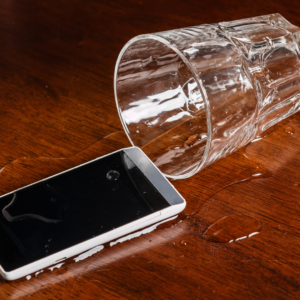
If you’re like most people, your smartphone is an essential part of your daily life. You rely on it for communication, entertainment, and staying connected to the world around you. But what happens when your phone gets wet and stops working? Water damage is a common problem that can happen to anyone, and it can be a frustrating and stressful experience. Lets take a look at what you should do if you find yourself in this situation, including what not to do. Whether you dropped your phone in the sink or it got soaked in a rainstorm, read on to find out what you should do next.
Signs of Water Damage
- iPhone gets hot
- No sound
- Won’t charge
- Can’t recognize SIM
- No service
- Boot looping
- Camera not working
- Display discoloration and flickering
- Won’t turn on
What to Do if Your Phone Gets Water Damage
Turn it off.
You do not want your phone operational and all those electric currents flowing around while water is in your device. It could instantly short-circuit your phone, and if that happens, there’s a good chance you can kiss your phone goodbye.
Do not plug it in.
It’s important to avoid plugging it in or charging it. This is because water can cause a short circuit in the phone’s electrical components, and applying electricity to the phone while it’s wet can cause further damage or even create a safety hazard.
Keep the Phone Still.
Absolutely do not try to shake out the water that’s gotten into your phone. Doing that will only worsen your situation, as the components that weren’t wet before will get wet because of your shaking. Also, try to keep your phone horizontal and as still as possible. Doing this prevents water from moving around in your phone, thereby causing more damage.
Wipe Excess Water.
Wipe off any water on the surface of your device with a microfiber cloth to prevent worsening your phone’s condition.
Remove the SIM card and SD card.
Take out your SIM card and microSD card, if you have one. Doing this prevents damage from coming to those ports and the peripherals or devices in those ports, and it also opens up another vent for air to enter your device and dry it.
Use Desiccant Instead of Rice!
Use desiccant, not rice! The risks of using rice far outweigh the minimal benefits. Using desiccants is more efficient as they draw out water better. While rice is inefficient and rice grains can cause more damage to your phone, for example, rice grains entering your charging port.
Give it Time.
Give your device at least two days to completely dry out before attempting to turn it on. In the event that the device turns on, make sure to immediately back it up. You see, water damage is complex, so the fact that your device turned on doesn’t mean it’s fine. Damage inflicted can take anywhere from a few minutes or hours to a few months to manifest.
Take Your Phone To A Repair Store.
As I said, damage caused by water can sometimes take a while to cause your phone problems. So once you’ve done everything above, the next thing you should do is take the phone to a repair store.
What Not to Do With Water Damage
Do Not Wait Too Long to Seek Repairs.
The longer you wait to seek repairs for a water-damaged phone, the more likely it is that the damage will become permanent. In some cases, waiting too long may even make repairs impossible.
Do Not Assume The Phone is Completely Fine.
Even if your phone seems to be working fine after exposure to water, there may still be internal damage that can cause problems down the line. It’s always best to have the phone inspected by a professional to ensure that it is fully functional and free from damage.
Do Not Use Extreme Heat or Cold
Some people believe that freezing a water-damaged phone can help fix it, but this is a myth. Freezing the phone can actually cause further damage to the device. On the flip side, ssing a hair dryer or other heat source to dry the phone can also cause damage. The heat can warp the phone’s internal components, leading to further problems.
Can an IP68 (Waterproof) Phone Get Water Damage?
IP68 is a rating system that indicates how well a device can withstand exposure to water and dust. An IP68-rated phone is designed to be water-resistant and can handle being submerged in water for a certain period of time. However, this does not mean that the phone is completely impervious to water damage.
While an IP68-rated phone can withstand exposure to water, it is not completely waterproof. The rating system specifies that the phone can be submerged in water up to a certain depth (usually 1.5 meters) for a certain period of time (usually up to 30 minutes) without suffering any damage. However, if the phone is exposed to water for a longer period of time or at a greater depth than its rating specifies, it may still suffer water damage.
Additionally, it’s important to note that the rating system only applies to fresh water. Exposure to saltwater or other liquids can still cause damage to an IP68-rated phone. It’s also important to follow manufacturer guidelines and not intentionally submerge the phone for extended periods of time, as this can increase the likelihood of damage.
One more thing on this: Damage like a cracked screen can make it easier for water to seep into your phone. So basically, your phone’s waterproofing reduces the more damaged it is.






